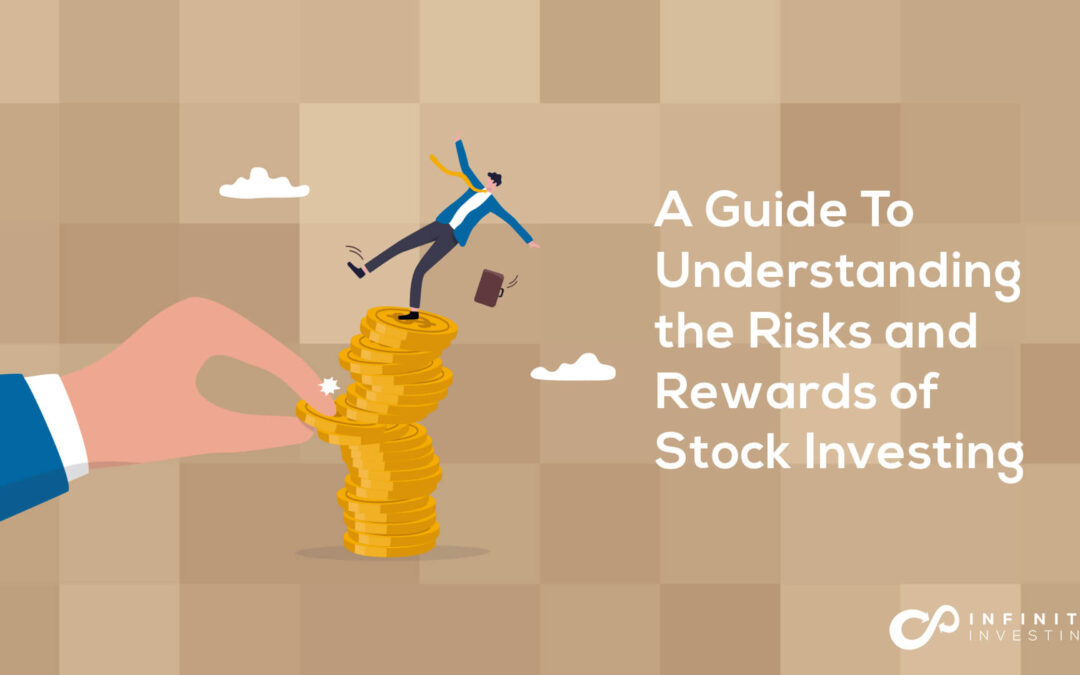
Stock investing allows you to buy partially into a company and then share its rewards if it does well. All investments carry some degree of risk, and learning how to predict and minimize that risk can help you maximize your rewards. This guide to stock investing covers the risks and rewards of individual stocks, including tips on how to minimize your risk.
Key Takeaways
- Stock investing is buying shares of a company for partial ownership that you may sell later for a profit.
- Investing in stocks offers many rewards, like capital gains, dividends, retirement planning, and financial freedom.
- A few common risks of investing in individual stocks include lost funds, not outpacing inflation, failing to meet your financial goals, and expensive fees.
- Determining your risk tolerance level is crucial before investing in stocks.
- Asset allocation and diversification are two of the best ways to manage the risks of stock investing.
Infinity Investing Featured Event
In this FREE event you’ll discover how the top 1% use little-known “compounders” to grow & protect their reserves. Our Infinity team of experts show you how to be the best possible steward of your finances and how to make your money and investments work for you instead of you working for them. Regardless of your financial situation today, you’ll have a road map to get to where you want to be.
What Is Stock Investing?
Stock investing is an investment strategy that involves buying shares or partial ownership of a company. Companies sell shares of their company to raise funds. If the company does well and earns money, your shares may increase in value, which means you can sell them for a profit. The risk and rewards of stock investing directly correlate with one another. As the risk of an asset increases, so does the potential reward. The safer the investment is, the potential reward also decreases.
Types of Stock Investing
You have a variety of stock buying options available, with public and private being the most common types. Public stocks are shares available through well-known companies, and private stocks are less common. To help manage risk, it’s usually a good idea to stick to public stocks since they’re traded in regulated markets. Stocks may also be common or preferred. Common stock comes with voting rights and potential dividend payouts. Preferred stock doesn’t typically have voting rights but may earn dividend payments at a higher rate.
Rewards of Stock Investing
Stock investing carries one of the highest potential returns on your investment. Some potential rewards of stock investing include:
- Capital gains: Capital gains are profits you earn from selling an investment. Stock investing has one of the highest potentials for capital gains, especially if you buy stocks that perform well.
- Earned dividends: Some stocks pay dividends, which are profits that a company shares with its shareholders. Investing in dividend-paying stocks can earn you both dividends and capital gains, helping you reach your financial goals even faster.
- Retirement preparation: Stock gains can be a great way to prepare for retirement. Adding stock investing to your retirement planning strategy with a retirement account can provide you with reliable income once you reach retirement age.
- Generate wealth: Choosing high-paying stocks and reinvesting dividends allows you to take advantage of compounding interest to generate wealth and obtain financial freedom.
- Outpace inflation: Inflation is a normal part of the economy. Because stocks have a higher chance of capital gains, they may also be one of the best options for outpacing inflation.

Risks of Stock Investing
Individual stock investing has one of the highest potentials for reward, but it also carries a moderate to high level of risk. Some of the risks of stock investing include:
- Loss of investment: A loss of investment occurs when you lose the full value of your premium. Stocks can be highly volatile, which means that they can quickly fluctuate in value.
- Failing to outpace inflation: You could lose money if your investments don’t keep up with or exceed inflation.
- Failing to prepare for retirement or other financial goals: Investing can be a great way to achieve your financial goals or prepare for retirement. However, if the stocks you invest in lose money and you don’t fill your portfolio with other options, you may not have enough saved for retirement.
- Expensive commissions or trade fees: Costly commissions or trade fees can significantly cut into profits, sometimes even leading to a loss.
- Tax penalties: Failing to account for your tax liabilities on stock earnings can lead to expensive penalties, also cutting into your revenue earned.
How To Manage the Risks of Stock Investing
Risk is a normal part of investing, and fortunately, there are several strategies available to help manage that risk. These are some of the top risk management strategies with stock investing:
Risk Review
Before investing, it’s important to consider your risk tolerance. This refers to how much risk you’re comfortable with when investing. Your risk tolerance level may vary depending on age, preferred lifestyle, and financial goals.
Many financial experts recommend adjusting your risk tolerance with age. When you’re younger, you have more time to fill your investment portfolio with riskier investments, like stocks. Even if you lose money, you have time to recoup your losses through other investments. As you get older and near retirement, you should reduce individual stock investing and consider safer options, like annuities or certificates of deposits (CDs).
Risk tolerance levels are typically described as conservative, moderate, and aggressive. Determining your level of risk before investing can help you decide the specific allocation of investments to include in your investment portfolio.
Research Stocks
Research is important when investing in stocks. When you buy a stock, you’re buying into the company and its ability to earn profits. Reviewing and comparing stocks against one another can help you choose the best ones. Consider things like management, budgets, performance reports, and previous performance results. Stocks are publicly traded companies, which means you can find a wide range of information on them that’s available to the public.
Risk/Reward Ratio
The risk/reward ratio refers to a specific method in which you can decide if individual stocks fit within your financial goals and risk tolerance level. A risk/reward ratio outlines the expected return of a stock versus the potential loss.
For example, a risk/reward ratio of 2:4 means an investor is willing to risk $2 per share for the potential reward of earning $4. Your specific risk/reward ratio makeup should match your personal goals and risk comfort level. Once you determine your risk/reward ratio, you can use this information as a foundation when choosing which stocks to include in your portfolio.
Asset Allocation/Diversification
Asset allocation is the strategy of creating an investment portfolio of different asset classes. Diversifying among those assets is the task of determining how much to invest within each asset class. A good diversification plan continues to evaluate and adjust assets over time. Ideally, you should rebalance your portfolio as your finances and goals change.
Another great way to diversify your portfolio is through a mutual or exchange-traded fund (ETF). Mutual funds allow you to invest in a collection of funds rather than a single stock. Even if one stock within the fund underperforms, you can offset your losses through the average or overperformance of another stock.
Financial Planning
Creating a financial plan ahead of time can help you determine what your risk and reward makeup should include. Consider your financial goals, the number of years until you retire, and your risk tolerance level. Decide at which age you’ll adjust your risk tolerance to accommodate your needs better.
Fund an Emergency Account Before Investing
One of the biggest risks of stock investing is losing your initial deposit and not having the funds you need to manage an emergency. Stocks are also somewhat illiquid, which means your invested funds are not readily available since you would have to sell before withdrawing them.
Funding an emergency account before investing in individual stocks can protect you from this risk. Ideally, you should have at least six months of expenses in an easily accessible liquidated account. Paying down debt, including credit cards, can also protect you from losses by reducing your monthly expenses. Additionally, this allows you to allocate more funds each month toward investing.
Stock investing has a high-risk, high-reward potential. If you’re able and willing to risk losses, you could potentially earn exceptional gains. The best stock investment strategy considers the risks and uses diversification, financial planning, and research to mitigate them. Continually reviewing and adjusting a stock investment strategy is also important to maximize rewards.

Learn to Balance the Risks and Rewards of Stock Investing With an Infinity Investing 360 Pro Membership
Do you want to learn more about how stock investing helps you achieve financial freedom? Sign up for our 360 Pro Membership to access all the tools and resources you need to build an investment strategy that allows you to reach your financial goals.
Infinity Investing Featured Event
In this FREE event you’ll discover how the top 1% use little-known “compounders” to grow & protect their reserves. Our Infinity team of experts show you how to be the best possible steward of your finances and how to make your money and investments work for you instead of you working for them. Regardless of your financial situation today, you’ll have a road map to get to where you want to be.

